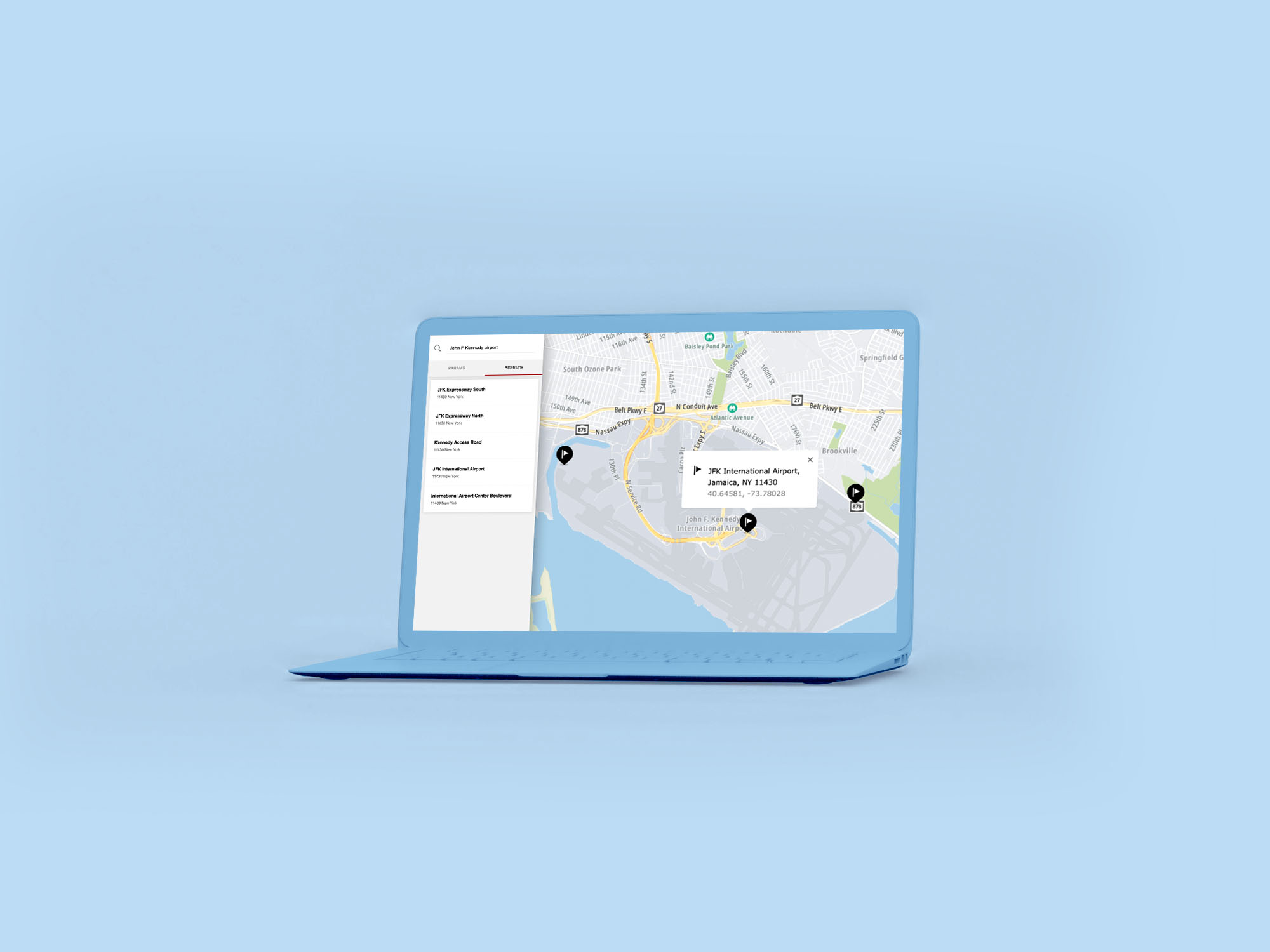Introduction
Decommission notice
December 16, 2025
- This service will be decommissioned on January 31, 2027.
- All endpoints will be withdrawn following a 12 months deprecation period.
- There is no recommended migration path.
What is TomTom's Location History API?
TomTom's Location History API is intended to keep track and manage the locations of multiple objects. It can share data with TomTom's Geofencing service to enhance it with the history of object transitions through fence borders.
Any object that has connectivity can send its location. It can be:
- A person
- A vehicle
- A package
- A telephone
The TomTom Location History API consists of the following services with endpoints.
Configuration service
The Configuration service is responsible for managing user's options. It is essential to create and to work with your account.
Objects service
The Objects service provides a client-side reporting device acting as a representation of items to record positions for.
Position History service
The Position History service providest tools to register object's position and read historical positions.
Archive service
The Location History API Archive service is responsible for downloading a user's data in one, compressed file.
Getting Started
Use the following topics to become more acquainted with this API and its endpoints.

How to get a TomTom API Key
When you use our location Service APIs, we need a way to identify that it is your application that is making the request to use the service (API).

TomTom Knowledge Base
The TomTom Knowledge Base optimizes the retrieval of information via articles, blogs, FAQs, tutorials, and videos for your use and reference.

Location History API Service Basics
TomTom Location History API services offer the ability to build applications based on object location histories. The Location History service can potentially be used for managing vehicle fleets, handling optimal taxi pickup locations, and for delivering on-demand services. This article introduces you to some of the concepts behind location history services and provides an overview of the services and endpoints provided by the Location History APIs.

Creating a Real-Time Construction Fleet Planning App with TomTom Maps APIs
Learn how to build a construction fleet planning application using TomTom’s Routing API with its Calculate Route method to calculate the possible routes, the Location History API to track a vehicle location, and the Geofencing API to determine when construction vehicles are close to the site.
Location History API services
Important note:
Before a customer can use Location History endpoints they must register.
- Registering creates a configuration for the customer and creates an Admin Key, used to create/edit/delete Location History data.
- Use the Register Admin Key endpoint in the Configuration service to do this.
Libraries of objects
For Location History to work, you need to create a library of your objects and optionally define their attributes.
Features
The following features are included in the Location History API.
- A Location History service.
- Location History configuration that is securely stored by TomTom in the cloud.
Current limits include:
- 1k objects
- Location history is kept as active data for 3 months.
- Location history is kept as a cold archive 6 months after the active period.
To change any of these limits, please contact your TomTom licencing assistant.
Services with endpoints
Configuration service
The Configuration service is responsible for managing one's options. It is essential to create and work with one's account.
POSTRegister Admin KeyPOSTRegenerate Admin KeyPOSTChange customer secret
Objects service
The Objects service provides a client-side reporting device acting as a representation of the item to be geofenced.
GETList objectsGETGet object detailsPOSTAdd new objectPUTEdit objectDELETEDelete object
Position History service
The Position History service provides tools for managing objects' location data.
DELETEClear objects position historyGETGet objects position historyGETLast positionPOSTSend position
Archive service
The Archive service is a tool for downloading user's data in a single, compressed file.
GETArchive structureGETArchive historical positionsGETDownload prepared data
Interactions with other APIs
Geofencing API
The Location History API and Geofencing API share Objects when both are on the same account. Each API has access to a view of an Object that is relevant for the given API. In the Location History API view, the name and properties fields are available for an Object.
The Location History API and Geofencing API share the consentForStoringObjectsPositionsHistory setting. When this setting is set to true both services can save an Objects' positions. Positions saved from the Geofencing API and Location History API are available from the Location History API endpoints.
Quick start guide
Configuration
Your API and Admin Keys
You need to have two keys to work with Location History:
- An API Key: This allows you to work with any TomTom Maps API, including Location History.
- An Admin Key: This is used by Location History to administer (create, edit, delete) your objects and location history.
Getting started
Follow these steps to start working with the Location History API:
Step 1. Register for an API Key
This key will let you read data from the service and request reports. In addition, it will let you register for an Admin Key.
Step 2. Register an Admin Key
To register for an Admin Key, use the Configuration service Register Admin Key endpoint. An Admin Key is used to manage objects within the Location History API.
Note: Constants and parameters enclosed in curly brackets { } must be replaced with their values.
Register for your Admin Key using this URL:
URL request example - HTTP Method: POST
1https://api.tomtom.com/locationHistory/1/register?key={Your_API_Key}2{3 "secret": "your_secret"4}
or use the POST curl command. See the following example:
1curl -XPOST "Content-type: application/json" -d2'{3 "secret": "your_secret"4 }'5'https://api.tomtom.com/locationHistory/1/register?key={Your_API_Key}'
The secret has to be between 10 and 30 characters. The secret is a password used to regenerate a stolen or lost Admin Key. It will not be asked for in any other circumstances.
The endpoint returns a generated Admin Key. For example:
1{2 "adminKey": "ooCP41LoslEhThwNPyCFjtTsgCDyJgTaoz9JJFpVJvW8MjA3"3}
You should save your Admin Key for administrative calls. You can fully manage your account in the Location History API when you have both the API Key and Admin Key.
Step 3. Creating objects
For each entity to be located (person, vehicle, package, telephone, etc.) an object has to be created using the Object service Add new object endpoint.
URL request example
1https://api.tomtom.com/locationHistory/1/objects?key={Your_API_Key}&adminKey={Your_Admin_Key}2{3 "name": "A Volvo Car"4}
curl command request example
1curl -XPOST "Content-type: application/json" -d2'{3 "name": "A Volvo Car"4 }'5'https://api.tomtom.com/locationHistory/1/objects?key={Your_API_Key}&adminKey={Your_Admin_Key}'
Step 4. Register an object's position
Each object can report its current position using the Position History service Send position endpoint.
URL request example
1https://api.tomtom.com/locationHistory/1/history/positions?key={Your_API_Key}2{3 "type": "Feature",4 "geometry": {5 "type": "Point",6 "coordinates": [7 4.909934,8 52.377607,9 010 ]11 },12 "object": "{Your_Object_Id}"13}
curl command request example
1curl -v -XPOST -H "Content-type: application/json" -d2'{3 "type": "Feature",4 "geometry": {5 "type": "Point",6 "coordinates": [7 4.909934,8 52.377607,9 010 ]11 },12 "object": "{Your_Object_Id}"13}'14'https://api.tomtom.com/locationHistory/1/history/positions?key={Your_API_Key}'
Step 5. Getting an object's position history
Historical positions can be retrieved using the Get objects position history endpoint.
URL request example
https://api.tomtom.com/locationHistory/1/history/positions/{Your_Object_Id}?key={Your_API_Key}&from=2019-08-27T12AM
curl command request example
curl 'https://api.tomtom.com/locationHistory/1/history/positions/{Your_Object_Id}?key={Your_API_Key}&from=2019-08-27T12AM'
Roles in Location History
Each Location History API user has a Role assigned to them. Roles define activities that a user can perform within the service.
Entity | Description |
|---|---|
| The owner of the API Key.
|
| A client-side entity with read-only rights for data within a configuration. The Requester only requires an API Key to query the service. |
| A client-side entity with rights to create, read, update, and delete data belonging to an account (identified by an API Key) that it is assigned to. To perform administrative functions, the Admin requires both an API Key and an Admin Key. |
| A client-side reporting device that acts as a representation of the thing to be located (a person, drone, vehicle, etc.). It is defined on the customer side by an Admin. An Object has the following characteristics:
To query the service, an Object only requires an API Key. |
Note: Both "Requester" and "Admin" are sometimes called "user" if their respective rights do not conflict. | |
Entities in Location History
Entities are manageable elements within the Location History API.
Entity | Description |
|---|---|
| The object's coordinate on earth, obtained by GPS sensors or otherwise. |
| A series of objects with their attributes, referred to by an API Key.
|
| An object's historical location representation that contains the following information for a specified object:
|
| Customer key | 1 ——— 1 | Configuration | 1 ——— 0..* | Object | 1..* ——— 0..* | Position |
|---|
Rights in Location History
Rights describe types of actions that a user can perform within the Location History API.
Legend to the following data table
-
(C)reate: an entity can create new objects.
-
(R)ead: an entity can get details about an object, generate position reports and send current position.
-
(U)pdate: an entity can change attributes and properties of objects.
-
(D)elete: an entity can delete objects and location history data.
Object
Archive
C R U D C R Admin+ + + + + + Requestor/Object- + - - - -